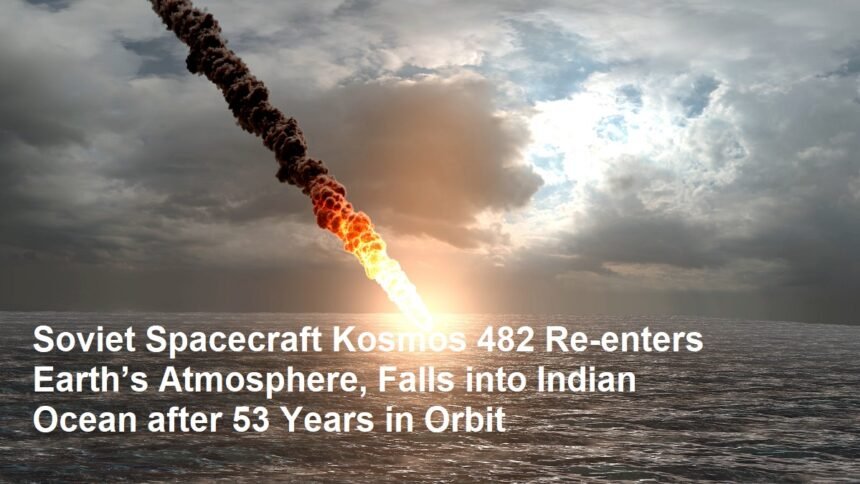On May 12, 2025, the Russian space agency Roscosmos announced that a Soviet-era spacecraft, Kosmos 482, re-entered Earth’s atmosphere and fell into the waters of the Indian Ocean near Indonesia after spending more than 50 years orbiting the planet. This event marks the end of a remarkable journey for a spacecraft launched in 1972 as part of the Soviet Union’s ambitious Venera program, which aimed to explore Venus. The re-entry of Kosmos 482 highlights both the legacy of early space exploration and the ongoing challenges posed by space debris in Earth’s orbit.
Kosmos 482 was launched in 1972 with the goal of reaching Venus and collecting valuable scientific data about the planet’s atmosphere and surface. However, the mission was cut short due to an apparent engine malfunction shortly after launch, which prevented the spacecraft from leaving Earth’s orbit and continuing its journey to Venus. Instead, Kosmos 482 became stranded in low Earth orbit, where it remained as a piece of space debris for over five decades.
On the morning of May 12, 2025, Roscosmos confirmed that Kosmos 482 had re-entered the Earth’s atmosphere and descended into the Indian Ocean, approximately 350 miles west of Middle Andaman Island, off the coast of Myanmar and near Indonesia. This location is significant because it lies over a vast expanse of ocean, minimizing the risk of debris causing harm to populated areas. NASA corroborated the timing and location of the re-entry, adding further confirmation to the event.
The European Union’s Space Surveillance and Tracking network reported that the spacecraft most likely survived the intense heat and friction of re-entry and reached the ocean’s surface almost intact. However, given the remote location of the landing, any surviving fragments of Kosmos 482 are expected to be difficult to locate and recover. This is a common outcome for many pieces of space debris that re-enter over oceans, which cover about 70% of the Earth’s surface.
The re-entry of Kosmos 482 serves as a reminder of the long-lasting presence of human-made objects in space and the growing issue of space debris. Since the dawn of the space age, thousands of satellites, spent rocket stages, and defunct spacecraft have accumulated in Earth’s orbit. While many eventually burn up upon re-entry, some larger objects can survive and pose potential risks to people and property on the ground. Fortunately, in this case, the spacecraft’s descent over the ocean greatly reduced any danger.
The Venera program, to which Kosmos 482 belonged, was a pioneering Soviet effort to explore Venus, the second planet from the Sun. Despite the failure of Kosmos 482’s mission, the program ultimately achieved significant successes with later spacecraft that successfully landed on Venus and transmitted valuable scientific data back to Earth. These missions contributed greatly to our understanding of Venus’s harsh environment, including its extreme temperatures, dense atmosphere, and volcanic activity.
The story of Kosmos 482 also underscores the importance of space situational awareness and debris tracking. Agencies like Roscosmos, NASA, and the European Space Agency continuously monitor objects in orbit to predict re-entries and mitigate risks. This monitoring helps provide advance warnings to governments and the public when large objects are expected to re-enter, allowing for precautionary measures if necessary.
As space activity continues to increase with more countries and private companies launching satellites, the challenge of managing space debris becomes ever more critical. The re-entry of long-orbiting objects like Kosmos 482 is a natural part of this process, but it also highlights the need for sustainable practices in space operations, including designing satellites to deorbit safely at the end of their missions and developing technologies to remove debris from orbit.
In conclusion, the fall of the Soviet spacecraft Kosmos 482 into the Indian Ocean near Indonesia after more than 50 years in orbit is a significant event that connects the history of space exploration with contemporary concerns about space debris. It reminds us of the achievements and challenges of humanity’s ventures beyond Earth and the ongoing responsibility to manage the space environment carefully. While Kosmos 482’s mission to Venus was never realized, its long journey orbiting Earth and eventual return to the planet’s surface is a fascinating chapter in the story of space exploration.









